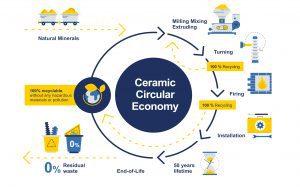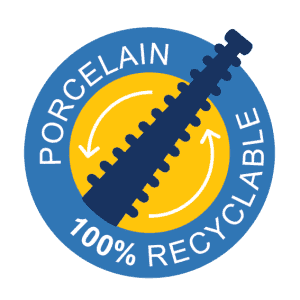Porcelain Insulators are Naturally Green
Porcelain insulators are green and ecological products for energy transmission and distribution for three reasons:
- local minerals requiring minimal refining are used,
- they have extremely long service life,
- and finally at end-of-life the porcelain is an inert, non-hazardous and fully recyclable material.
Ceramic materials are one of the oldest technical materials that homo sapiens have invented, if not the oldest. Depending on the source, the beginning of manufacturing of ceramic objects is dated between 26’000 – 20’000 B.C. Today PPC’s modern C-130 Porcelain Insulators are generally known hi-tech ceramics, with a carefully tuned recipe of minerals and advanced process controls. But very few people know that Ceramic Insulators are also green products with a very low carbon footprint.
On first view, one could think that manufacturing ceramic insulators is an energy intensive and polluting industry, but it is exactly the opposite. Basic minerals, like kaolin, feldspar, bauxite and clays etc. are used without expensive and complicated refining operations. All these minerals are widely available everywhere on this planet, allowing the use of local mining sources and reducing the logistics carbon footprint. Once the raw materials are in the plant, they are mixed and milled to the right recipe, extruded, shaped and finally fired.
Firing happens in a high temperature kiln, up to 1’400 °C, but this doesn’t mean that the energy is wasted. Today’s industrial firing kilns are far from the ancient kilns heated by wood or carbon, and energy efficiency is the major design criteria. PPC Insulators uses tight gas-kilns with advanced thermal insulating materials and coatings. Further, heat-exchangers are used to reuse the energy from the process. The possibility of using Bio-Methane is currently being studied with gas- suppliers.
The other technology used in the industry is composite insulators which are manufactured of Glass-Fiber reinforced Epoxy bar and a silicon housing. These are already semi-finished components, having many different energy consumptive operations and logistics trips behind them. It is difficult to calculate any generic Carbon-dioxide equivalent for one composite insulator as there are just so many variables and the supply chain and processes vary greatly among manufacturers. Epoxies are organic materials refined from fossil raw-materials, which have a typical Carbon-dioxide equivalent, depending on the source and type, of between 5-7 kg CO2-eq/kg per one kilogramme epoxy. In addition, Methyl Siloxane, which is the base-material for manufacturing silicon used as the housing, has a Carbon-dioxide equivalent of 6.58 kg CO2-eq/kg +/- 25 %. (1)
The carbon-dioxide equivalent of a ceramic material is as well strongly dependent on the manufacturer, factory, season, and product mix, making it impossible to give an accurate generic industry value. PPC Insulators has focused for years on energy management and savings, and we naturally follow our carbon footprint closely. The porcelain Kyoto agreement Scopes 1 and 2 values vary between 1.0 kg CO2-eq/kg and 2.0 kg CO2-eq/kg, which is roughly 3-4 times lower than the values for the base materials of composites. Our ambition is to reduce our carbon footprint even more and we are actively working on and studying technologies which would make zero emission possible.
When talking about the carbon-dioxide equivalent, the analysis should be based on the total life-time footprint, not only on the Greenhouse Gas Protocol Scope 1 and 2. GHGP Scope 3 includes the up- and downstream activities and related carbon emissions. Here the impact of the lifetime and the end-of-life treatment is taken into account, which will make ceramic insulators an even more ecological solution.
The average lifetime of composite insulators has improved from the early days, but it remains the “Achilles heel” of the composite industry. Just looking at the number of Cigré and IEEE articles (4) shows it clearly: there are multiple issues with brittle fracture, silicon adhesion, carbolic acid, moisture penetration, and the list goes on. There are naturally huge difference between manufacturers and the aging behavior of their products, however field data suggests that on average after 12-15 years in the field the first failures appear with composite insulators (2). It can be said that ceramic insulators do not have these “childhood issues”; after all we are talking of a technology with several thousands of years manufacturing history. Even for the application as electrical insulator, there is over 100 years of field experience. There have been many cases where insulators installed on an original build are still in service until an upgrade is performed, sometimes as long as 70 years.
The High Voltage substation and Over-Head line ceramic insulators might have a service life of over 50 years (3). In contrast, if we look the composite insulators lifetime, the entire population must be changed at least once or even twice during the planned 50 years. This will quite dramatically increase the carbon footprint. 50 years is already quite an achievement for any materials, but it is not accomplished without effort. PPC has extremely strict criteria for the raw materials selection and applies the best quality controls throughout production. We are especially focused on the elimination of residual quartz content after firing; excess residual quartz can lead to premature fatigue cracks (5,6). PPC is one of very few manufacturers providing a certificate of quartz-free production.
Finally, there is the end-of-life phase: ceramic insulators are 100 % recyclable. The PPC ceramic material C-130 consists mainly of Aluminium-oxide c. 50% and Silicon dioxide c. 45 % with the remaining 5 % made up of various metal-oxides present in the raw material. All the minerals found exist in nature and are non-hazardous and non-toxic, making the recycling very easy and cost effective. At PPC we recycle 100 % of the porcelain production waste either internally in process or externally. Externally it is a valuable raw-material for the construction and chemical industries. The same applies for insulators at the end-of-life.
Composite materials are quite problematic when it comes to recycling, with separation of materials being an issue. This is already environmental problem with windmill blades- how to recycle them after 20 years is currently unsolved and they currently go to landfills (7). The composite insulators could potentially be incinerated for their energy, but it must be processed at an installation specializing in elimination of hazardous waste, the energy content would be limited and the whole operation further increases the carbon dioxide footprint.
Polymer industry remains very secretive of the exact substances used in the epoxy and silicon, and there are potentially a lot of additives, fillers, hardeners, etc.; which might already be or are at risk in the future to be classified as Substances of Very High Concerns according to REACH. This REACH compliance risk doesn’t exist with the minerals used for C-130 porcelain.

In all Ceramic Insulators present a perfect example of the circular economy.
In conclusion: it is impossible to make an exact generic lifetime calculation of the total carbon footprint of one defined insulator. There are many differences between manufacturers of ceramic insulators and composite insulators, their technologies, materials used and field servicing conditions. But there are three facts which make a PPC insulator a very green option:
- green and natural local raw materials
- very long lifetime
- 100 % recyclability with low carbon footprint and without hazards after the end-of-life.

PPC Insulators is not content to stop here, being just a bit greener than other manufacturers; we are developing several R&D initiatives to further reduce our carbon footprint and working toward the potential of Zero Carbon emissions by 2030.
PPC Group Quality and Research & Development Director
References:
- “Silicon Chemistry Carbon Balance” – 2019 Commissioned by Global Silicones Council
- EPRI – IEEE Memphis, Jan 2013
- “Testing Ageing of Porcelain Insulators” Ravi Gorur INMR
- Cigré 2020, Paris, several papers
- “Alumina Porcelain for High-Voltage Insulators” J. Liebermann, American Ceramic Society Bulletin Vo. 80, no 6
- “Microstructure Based Evaluation of Field Aged and New Porcelain Suspension Insulators. A. Rawat and R. Gorur, Arizona State University
- Wind Turbine Blades Can’t Be Recycled, So They’re Piling Up in Landfills, Bloomberg 05.02.2020



